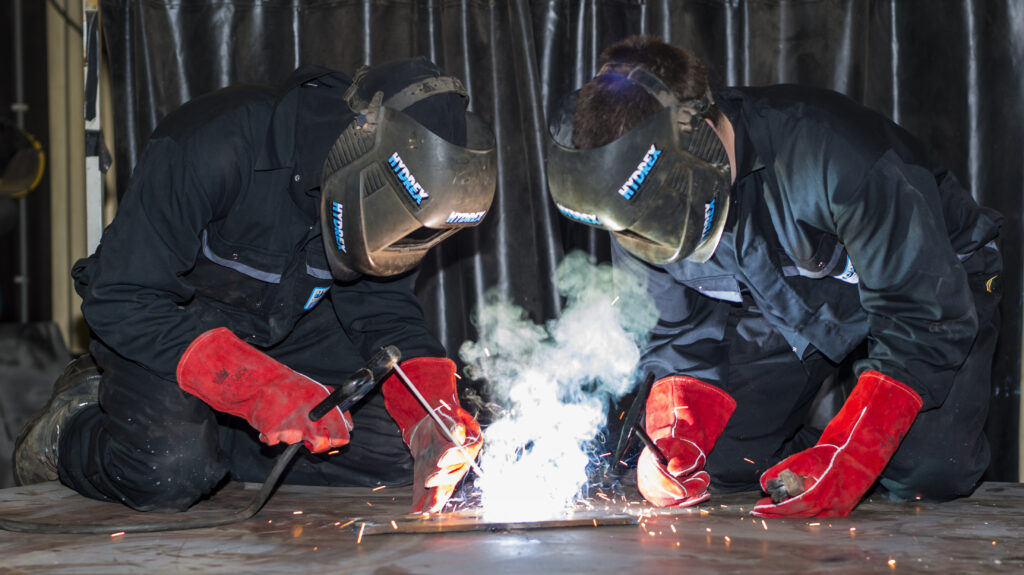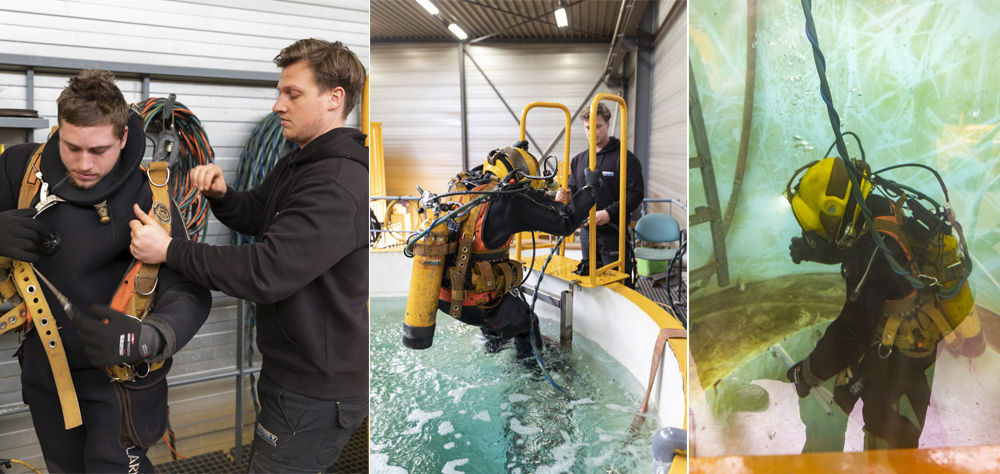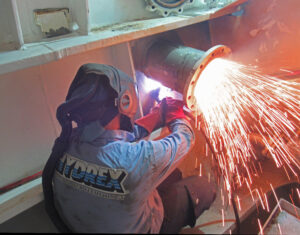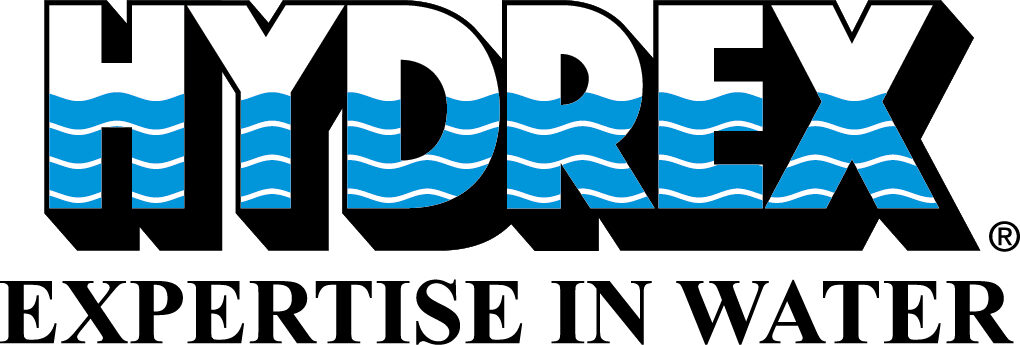Home - Core values - Technical training at Hydrex
Technical training at Hydrex
Technical training has, from the start, been a key contributor to the success Hydrex has enjoyed over the years. Perhaps a symbol of that fact is the 12-meter dive tank in the Hydrex Antwerp facilities which is used for underwater training. This is the original tank that was built in 1975 for that very purpose and which was brought to the current Hydrex depot in 1980.

Key to delivering the highest quality underwater repair and maintenance services rapidly and cost-effectively
Training is however much more than a dive tank. “Training is firstly a matter of knowing that you have to train people and deciding to do it as a continual process of improvement,” says Boud Van Rompay, the company’s founder and CEO. “Secondly, you have to have the right training materials and set-up.” From the early days of Hydrex, Boud wrote a technical diver manual along with other standard texts, and regularly referred his divers to them and encouraged their study. Safety training was also very important from the start. As time went on and Hydrex developed many technical procedures, these were tabulated and compiled so that new divers could learn from them.
“For me, the most important factor is finding the right level to start someone in on,” says Boud. “If you find the right starting point, he can have a smooth learning curve and become a true expert.”
“With welding, they must study the theory. You have to know your steel,” he adds. “Then it’s a matter of the safety aspect and how to set up the equipment. There’s a big difference between how you put on a dive suit in a diving school and putting it on when you are going to weld,” says Boud.
Study and on-the-job training
Of course, classroom training and the dive tank are very different from being on a job. But the training carried out in the depot and the classroom are vital for the learning diver to deal successfully with the situations encountered in “real life.”

Senior Diver Jonathan De Kerf came to Hydrex with a diving certificate and no previous experience in underwater repair and maintenance. “It’s helpful to practice welding in the tank before you go out on a job,” he says, “But it’s totally different from the real thing: the visibility and other conditions are all optimum in the tank. It’s definitely beneficial to spend some hours learning and practicing welding and getting used to the basics. It’s also worthwhile to study the procedures so that you are prepared for how things go and know what’s next when you are carrying out a stern tube seal repair or thruster repair or any other job. That way you can be prepared. But the way to really learn is on the job.”
Clément Paquet, a very experienced Senior Diver agrees: “It’s good that the new divers come on the job somewhat prepared, but in the end, most of what they will learn will be from participating in the operations themselves.”The complexity of the jobs which the Hydrex divers are used to tackling on a daily basis is very high. Add to that the additional factors which come with working underwater, and it can be overwhelming. But, with each of the procedures studied and practiced, the sequences mastered, and with the teamwork required for mutual support, the most complex jobs can be completed rapidly to the high standards which Hydrex is known for.
“The main reason that our team completes jobs so rapidly is the amount of training we insist on,” says Boud.

We do not provide diver training. Anyone who starts work at Hydrex as a diver must already have had proper dive school training. We teach them welding and the technical procedures and make sure they are competent with those. Much of the training is done on an apprenticeship basis, where experienced divers ensure that the newer ones acquire the skills needed. Teams are carefully put together to include one or two student divers who can further their skills and competence while carrying out necessary work on the operation.
Toon Joos, Chief Diver, is overall in charge of the training and proficiency of the Hydrex diver technicians. “Most of the training is done on the job,” he says. “They do some study here and practice welding which helps when they are on an actual operation. Another important aspect they do learn here is the loadout before going to the job and the loadin on their return. This is vital. If you arrive on a job without all the needed equipment and all in working order, it makes the job much harder. And on returning, everything needs to be checked and in working order before it goes back on the shelf, or it is set aside and tagged for repair.”
It’s interesting that “loadout” was originally a military term for the equipment carried into battle and had to include everything needed to survive in a life-or-death operation. An incomplete loadout could lead to failure or worse.
On the job itself, the Senior Diver or Team Leader in charge of the operation and its success explains what needs to be done and then lets the divers get on with it while watching to make sure everything is done correctly. Where possible, a newer diver is teamed up with a veteran so that he can gain experience.

It takes time to make a real expert
“It takes 4-5 years on average for someone to learn everything they need in order to go out on one of the more complex jobs such as a seal repair, thruster repair, or a hull repair requiring a custom cofferdam,” says Toon. “Not everybody reaches that level, either from a technical or a leadership point of view.”
Clément agrees that it usually takes five years for someone to reach the level of proficiency required to be sent out in charge of a team to carry out the more complex jobs. “The most difficult procedures to teach are bow thruster repairs and seal repairs,” he says. “When I am on a job, I instruct all the time through the communications system from dive station to the divers and follow their actions on the monitor. Some of the divers don’t need much guidance. Others I follow carefully and correct them if needed. We have eyes on the job all the time through the monitor.”
Jonas Toelen is the newest and youngest student diver at Hydrex at time of writing. He came to Hydrex straight from school and a diving course and had some experience with dry welding. He has been learning through study of the procedures and practice but mostly on the job. The attitude of his teammates is a major plus in his leaning process. “The other colleagues feel like a family in this company,” he says. “I’m happy to come to work every day. I love my job and the colleagues are good friends so it’s amazing to work here.” Already he is tackling more complex and involved jobs and gaining valuable experience. While learning he is a valuable member of the team performing vital functions. Having a team leader like Toon, Clément or Jonathan or some of the other more experienced divers who have reached the top of their profession in terms of knowledge and skill is vital. Their taking the time to impart their knowledge and experience to the newer divers makes it possible for these to gain the knowledge and experience needed to make them into real professionals. Then they in turn are able to lead the most complex jobs under the most trying conditions imaginable.
The accumulated know-how, skill and experience is one of the main factors that sets Hydrex apart from anyone else in the field.
If you have any questions regarding our underwater services, do not hesitate to contact us. We are at your disposal 24/7 and ready to mobilize almost immediately.
+32 3 213 53 00
hydrex@hydrex.be
News and projects

Shell plating repairs across the globe: the Netherlands, France, the Philippines, and Trinidad
In recent months, Hydrex specialized diver/technician teams have traveled to key ports around the world—including Port of Spain (Trinidad), Batangas

Efficient overboard pipe repairs in France and the Netherlands
In the ports of Marseille and Rotterdam, our expert diver/welders recently executed vital overboard pipe repairs on two tankers, demonstrating

Underwater bow thruster removal and reinstallation in Algeciras
To save time and money for the owner of a 150-meter roro ship, our divers removed the bow thruster of
